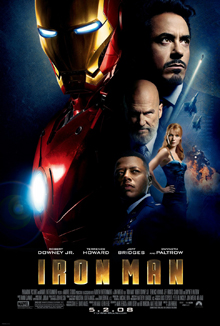Iron Man (2008), starring Robert Downey Jr., is the film that launched the Marvel Cinematic Universe. Read our detailed review of this iconic superhero film, its impact, performances, and legacy.

Iron Man (2008) – Movie Review | The Birth of a Billion-Dollar Cinematic Empire
Movie Title: Iron Man
Language: English
Genre: Superhero / Action / Sci-Fi
Director: Jon Favreau
Cast: Robert Downey Jr., Gwyneth Paltrow, Jeff Bridges, Terrence Howard
Release Date: May 2, 2008
Runtime: 126 minutes
Production: Marvel Studios
Distributed by: Paramount Pictures
Best Movie Review (BMR) Rating: 9/10
Introduction
Before Iron Man hit theaters in 2008, superhero films were dominated by standalone franchises like Spider-Man, X-Men, and Batman. What no one expected was that this relatively lesser-known Marvel character, played by a then-controversial actor, would revolutionize the genre and lay the foundation for what is now the most successful film franchise in history: the Marvel Cinematic Universe (MCU).
Directed by Jon Favreau and led by Robert Downey Jr. in a career-redefining performance, Iron Man isn’t just a superhero movie—it’s a cultural reset that changed how audiences and studios approached interconnected cinematic storytelling.
Plot Summary
Tony Stark (Robert Downey Jr.) is a billionaire industrialist, genius inventor, and playboy who runs Stark Industries, a company that manufactures advanced weapons for the U.S. military. During a weapons demonstration in Afghanistan, Stark is ambushed and taken hostage by a terrorist group called the Ten Rings. Wounded by shrapnel near his heart, he is kept alive by a magnet-powered device built by fellow captive Yinsen (Shaun Toub).
While in captivity, Stark has a life-altering realization about the destructive impact of his weapons. Instead of building missiles for his captors, he secretly constructs a suit of powered armor to escape. After his return to the U.S., Tony announces that Stark Industries will no longer produce weapons—a decision that angers his business partner Obadiah Stane (Jeff Bridges).
Determined to make amends for his past, Stark perfects his Iron Man suit and sets out to dismantle the very system he once profited from. But a deeper betrayal awaits him, leading to an epic showdown that sets the tone for the entire MCU.
Performances
Robert Downey Jr. owns the role of Tony Stark with unmatched charisma and depth. His sarcastic wit, emotional vulnerability, and commanding screen presence made Tony Stark one of the most beloved and iconic characters in film history. It’s impossible to imagine anyone else delivering the famous line, “I am Iron Man.”
Gwyneth Paltrow brings sincerity and intelligence to her role as Pepper Potts, Tony’s loyal assistant and moral compass. Their chemistry adds both humor and heart to the narrative.
Jeff Bridges as Obadiah Stane delivers a solid performance as the film’s antagonist, though his villain arc feels slightly predictable. However, his transformation into Iron Monger adds weight to the final act.
Terrence Howard, as James “Rhodey” Rhodes, adds professionalism and military grounding to Stark’s wild genius, hinting at a bigger role in future MCU films.
Direction and Screenplay
Jon Favreau’s direction is tight, grounded, and refreshingly character-driven. The film strikes a perfect balance between action, humor, and emotional arcs. The screenplay, credited to Mark Fergus, Hawk Ostby, Art Marcum, and Matt Holloway, captures the spirit of Tony Stark’s transformation from arrogant arms dealer to a self-reflective hero.
Much of the film’s dialogue, especially Stark’s quips, was improvised—adding to the naturalism and sharp wit of the characters. This improvisational approach became a hallmark of MCU films moving forward.
Visuals and Music
Iron Man delivers stunning special effects for its time, especially in the suit-up scenes and aerial combat sequences. The Mark I, II, and III suits are crafted with intricate detail, setting a benchmark for future films. The CGI holds up remarkably well, with practical effects blended seamlessly into the action.
The score by Ramin Djawadi, including the iconic heavy-metal-inspired theme, perfectly complements Tony’s rebellious and rockstar-like persona. The use of Black Sabbath’s “Iron Man” in the closing credits is an unforgettable moment.
Themes and Symbolism
The central theme of Iron Man is redemption. Tony Stark’s evolution from a careless profiteer to a responsible hero mirrors a personal journey of accountability. His heart, once saved by an electromagnet, becomes the film’s metaphor—he gains not just a new purpose, but a literal change of heart.
The film also touches on real-world issues like arms dealing, terrorism, and corporate greed, grounding the story in a more believable context than previous superhero films.
Cultural Impact
More than just a successful standalone film, Iron Man launched the MCU and popularized post-credit scenes (remember Nick Fury’s “Avengers Initiative”?). It proved that lesser-known characters could carry a film franchise and showed how superhero films could be smart, fun, and deeply character-driven.
This film was also a turning point for Robert Downey Jr., whose career was revitalized, making him one of the highest-paid actors in Hollywood.
Positives
- Stellar performance by Robert Downey Jr.
- Sharp, witty script with emotional weight
- Groundbreaking special effects
- A perfect blend of action, humor, and heart
- Launched the Marvel Cinematic Universe
Negatives
- Predictable villain arc
- Final battle slightly underwhelming compared to later MCU climaxes
- Rhodey’s character underutilized (later recast in sequels)
Final Verdict
Iron Man (2008) isn’t just a superhero movie—it’s a genre-defining, franchise-launching cinematic landmark. With its strong character development, compelling themes, and crowd-pleasing action, it set the gold standard for modern superhero films.
Best Movie Review (BMR) Rating: 9/10